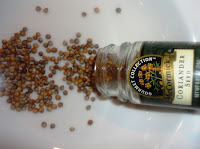Corriander
History
It is believed to have originated in the Mediterranean area, and in southwest Europe. It is also the native to southwestern Asia to north Africa. Coriander is probably one of the first spices used by mankind, having been known as early as 5000 BC. Sanskrit writings dating from about 1500 BC also spoke of it. The Romans spread it throughout Europe and it was one of the first spices to arrive in America. The parts used are the fruit, and the leaves
Culinary Uses
All parts of the plant are edible, but the fresh leaves and the dried seeds are the most commonly used in cooking.
The leaves have a very different taste from the seeds, similar to parsley but "juicier" and with citrus-like overtones.
The small, woody root is used as a vegetable in some parts of China.
Chopped coriander leaves are also used as a garnish on cooked dishes such as curries, but should never themselves be cooked as heat destroys their delicate flavor quickly.
The fruits are also used (both whole and ground) in baking, sausages, pickles, candies, sauces and soups.
Coriander seeds are also used in brewing certain styles of beer, particularly some Belgian wheat beers.
They are usually dried but can be eaten green. Ground coriander is a major ingredient in curry powder
Medicinal Purposes
Coriander is used to treat digestive ailments. .
One pharmaceutical use of coriander is to mask the tastes of other medicinal compounds or to calm the irritating effects on the stomach that some medicines cause.
Coriander has been used as a folk medicine for the relief of anxiety and insomnia in Iranian folk medicine.
If used too freely the seeds become narcotic.


No comments:
Post a Comment